best graphics design video card
Best Graphics Cards for Gaming in 2021
Included in this guide:

The best graphics cards are the lifeblood of any gaming PC — they're they're the beating heart pumping out stunningly rendered pixels to your screen. While there's no single solution that's right for everyone, we're here to sort out the must haves from the wanna bes. Some want the fastest graphics card, others the best value, and many are looking for the best card at a given price. Balancing performance, price, features, and efficiency is important because no other component impacts your gaming experience as much as the graphics card.
Where our GPU benchmarks hierarchy ranks all of the cards based purely on performance, our list of the best graphics cards tries to look at the whole package. Price, availability, performance, features, and efficiency are all important, though the weighting becomes more subjective. With Bitcoin and Ethereum prices on the rise once more (for how long, we couldn't say), and continued supply chain issues, reasonably priced graphics cards are nowhere in sight.
AMD's Radeon RX 6600 and Radeon RX 6600 XT have now joined our benchmarks, with the latter earning a spot on our list of the best graphics cards. Unfortunately, pricing and availability of all the best graphics cards remains terrible, with GPU prices on places like eBay often 50–100% higher than the official launch prices. Meanwhile, with the hashrate limiter on Nvidia's cards at least partially bypassed, pricing on the RTX 30-series cards continues to be higher than the competing AMD cards, though supply is generally higher.
While AMD's FSR, FidelityFX Super Resolution, has now been out for a few months, and Nvidia's DLSS has been around for a few years, none of the games in our core suite of benchmarks support FSR. That means we're running at native resolution for all of these tests. We have a separate article looking at FSR and DLSS, and the bottom line is that DLSS improves performance with less compromise to image quality, but FSR works on any GPU.
We're going to list the best graphics cards that are theoretically available right now, along with their nominal prices. As an example of the problem we face, the GeForce RTX 3060 12GB sells for around $700 on eBay, and the Radeon RX 6700 XT goes for over $800 — both more than double the suggested etail pricing (SEP). If you're desperate for a new GPU, you could maybe justify paying 25% more than the launch price, but double or triple the MSRP is simply too much. If you need to upgrade, we recommend taking a look at pre-built
gaming PCsinstead. Or just wait, but prices might not get back to anything close to 'normal' until some time in late 2022.
We test and review all the major GPUs, and we've done extensive testing of
graphics card power consumption, using proper hardware. We've also looked at the broader
AMD vs Nvidia GPUsbreakdown. All of these GPUs were tested using a Core i9-9900K PC, though in previous testing there wasn't a major difference between that CPU and the Core i9-10900K and Ryzen 9 5900X. We'll be looking to upgrade our testbed in the coming months, once we see how the upcoming AMD and Intel CPUs stack up. Here's our list of the best graphics cards that are currently in production, that might even be available to buy if you search around or get lucky.
Choosing Among the Best Graphics Cards
We've provided a dozen options for the best graphics cards, recognizing that there's plenty of potential overlap. The latest generation GPUs consist of Nvidia's Ampere architecture cards and AMD's RDNA2 architecture offerings. You can check our launch reviews of the GeForce RTX 3090, GeForce RTX 3080 Ti, GeForce RTX 3080, GeForce RTX 3070 Ti, GeForce RTX 3070, GeForce RTX 3060 Ti, and GeForce RTX 3060 12GB for Nvidia, along with AMD's Radeon RX 6900 XT, Radeon RX 6800 XT and RX 6800, Radeon RX 6700 XT, Radeon RX 6600 XT, and Radeon RX 6600. RDNA2 brought ray tracing support to Team Red for the first time and greatly improved performance compared to the previous generation GPUs. That's a baker's dozen of new GPUs in about as many months, and we probably won't see any new desktop GPU launches until early 2022 when the Intel Arc Alchemist GPUs arrive.
Theoretically, cards like the RTX 3070 and RX 6800 cost less than half as much as the previous generation RTX 2080 Ti, and generally match or beat it on performance. Meanwhile, the RX 6800 XT and RTX 3080 are 30% to 35% faster than the 2080 Ti for less money, and the RTX 3090 is 10-20% faster than the 3080 — at more than twice the price. You can also see how the RTX 3080 scales with a wider range of CPUs. Hint: You'll want something made in the past few years, generally with at least 6-cores and 12-threads, and 8-core and above add a few extra percent in performance.
Unfortunately, that's only in theory, as cryptocurrency mining combined with an already limited supply have caused a massive jump in GPU prices — see our GPU price index. Our advice: Don't pay more today for yesterday's hardware. If you want an RTX 30-series or RX 6000-series graphics card, be patient and you'll eventually be able to buy one at close to the official MSRP. If you already own a decent GPU, stick with it — or sell it for a premium and save the money until prices come down (assuming you have a spare you can live with in the interim). Or, hell, just give Ampere and RDNA2 a pass and wait for Lovelace and RDNA3, which will probably arrive in late 2022 and will hopefully have better availability (don't count on that yet!)
If your main goal is gaming, you can't forget about the CPU. Getting the best possible gaming GPU won't help you much if your CPU is underpowered and/or out of date. So be sure to check out the Best CPUs for Gaming page, as well as our CPU Benchmark hierarchy to make sure you have the right CPU for the level of gaming you're looking to achieve.
Our current recommendations reflect the changing GPU market, factoring in all of the above details. The GPUs are ordered mostly by performance, but price, features, and efficiency are still factors so in a few cases a slightly slower card may be ranked higher. There's been a massive shakeup at the top of the performance rankings already, and provided you can find the various cards in stock, these are the best graphics cards.
When buying a graphics card, consider the following:
• Resolution: The more pixels you're pushing, the more performance you need. You don't need a top-of-the-line GPU to game at 1080p.
• PSU: Make sure that your power supply has enough juice and the right 6- and/or 8-pin connector(s). For example, Nvidia recommends a 550-watt PSU for the RTX 3060, and you'll need at least an 8-pin connector and possibly a 6-pin PEG connector as well.
• Video Memory: A 4GB card is the minimum right now, 6GB models are better, and 8GB or more is strongly recommended.
• FreeSync or G-Sync? Either variable refresh rate technology will synchronize your GPU's frame rate with your screen's refresh rate. Nvidia supports G-Sync and G-Sync Compatible displays (for recommendations, see our Best Gaming Monitors list), while AMD's FreeSync tech works with Radeon cards.
• Ray Tracing, DLSS, and FSR: The latest graphics cards support ray tracing, which can be used to enhance the visuals. DLSS provides intelligent upscaling and anti-aliasing to boost performance with similar image quality, but it's only on Nvidia RTX cards. AMD's FSR works on virtually any GPU and also provides upscaling and enhancement, but on a different subset of games.
Note: Prices on most of the graphics cards remain seriously messed up right now. We've listed the official MSRPs, which is what we would expect to pay under normal circumstances. You shouldn't pay significantly more than the above prices, and nearly all of the top GPUs remain out of stock.While we sorted the above list in order of performance, we've sorted the cards below based on performance as well as our own subjective rankings. We look at performance, price, power, and features and then adjust things accordingly, though opinions naturally differ. Plus, it's very hard to know how to rank anything given the current prices.
Best Graphics Cards for Gaming 2021

1. GeForce RTX 3080
Best Graphics Card Overall, for 4K and More
Specifications
GPU: Ampere (GA102)
GPU Cores: 8704
Boost Clock: 1,710 MHz
Video RAM: 10GB GDDR6X 19 Gbps
TDP: 320 watts
Reasons to buy
+Excellent performance +Reasonably priced compared to 3090 and 6900 XT +Can legitimately do 4K ultra at 60 fps or more +Substantially faster than previous gen GPUs
Reasons to avoid
-Availability is severely limited -Requires 320W of power -Overkill for 1080p displays -Only 10GB VRAM
Nvidia's GeForce RTX 3080 sports the new and improved Ampere architecture. It's over 30% faster than the previous gen 2080 Ti, for $500 less. The new RTX 3080 Ti didn't manage to supplant the incumbent, thanks to its significantly higher pricing. If you're serious about maxing out all the graphics settings and you want to play at 4K or 1440p, this is the card to get — it's mostly overkill for 1080p gaming, though enabling all ray tracing effects in games that support the feature makes 1080p still reasonable.
If you skipped the first round of RTX GPUs, the RTX 30-series might finally get you you on board the ray tracing train. With potentially double the ray tracing performance of Turing, and games like Cyberpunk 2077 using even more ray tracing effects, the RTX 3080 is your best bet at playing games in all their ray traced glory without nuking the piggy bank.
Ampere also brings improved tensor cores for DLSS, a technology we're bound to see more of in future games now that it doesn't require per-game training by a supercomputer. We're seeing a lot more games with DLSS 2.0 these days, helped by the fact that it's basically a toggle and UI update to get it working in Unreal Engine and Unity. Nvidia's RT and DLSS performance are also quite a bit faster than what you get from AMD's new RX 6000 cards, which is a good thing as Nvidia sometimes falls behind in traditional rasterization performance (which is what our raw numbers are based on).
The biggest problem with RTX 3080 by far is going to be finding one in stock, at prices that aren't straight up terrible. Given the high price of the 3080 Ti, though, this remains our best pick for a fast GPU right now.
Read: Nvidia GeForce RTX 3080 Review

2. Radeon RX 6800 XT
Best AMD GPU, Forget About DLSS
Specifications
GPU: Navi 21 XT
GPU Cores: 4608
Boost Clock: 2,250 MHz
Video RAM: 16GB GDDR6 16 Gbps
TDP: 300 watts
Reasons to buy
+New RDNA2 architecture provides excellent performance +Beats 3080 in rasterization games +Easily handles 4K and 1440p +Lots of VRAM for the future
Reasons to avoid
-Weaker ray tracing performance -FSR needs wider adoption -Supply might be even worse than Nvidia
AMD's Radeon RX 6800 XT is the best card for Team Red. The RX Radeon 6900 XT is technically about 5-7 percent faster, but it costs 54 percent more. That's not a great deal, at all, especially since you don't get more VRAM or any other extras. The RX 6800 XT provides a massive boost in performance and features relative to the previous generation RX 5700 XT. It adds ray tracing support (via DirectX Raytracing or VulkanRT), and is 70-90% faster across our test suite.
The GPU was affectionately dubbed 'Big Navi' prior to launch by the enthusiast community, and we got exactly what we wanted. Navi 21 is over twice the size of Navi 10, with twice the shader cores and twice the RAM. Clock speeds are also boosted into the 2.1-2.3 GHz range (depending on the card model), the highest clocks we've ever seen from a reference GPU by about 300 MHz. And AMD did all this without substantially increasing power requirements: The RX 6800 XT has a 300W TDP, slightly lower than the RTX 3080's 320W TDP.
A big part of AMD's performance comes thanks to the massive 128MB Infinity Cache. It improves the effective bandwidth by 119% (according to AMD). We're confident that few if any games in the coming years are going to need more than 16GB, so the 6800 XT is in a great position in that area.
What's not to like? Well, the ray tracing performance is a bit mediocre. Maybe it's because current games are more likely to be optimized for Nvidia's RTX GPUs, but overall the 6800 XT is just barely ahead of the RTX 3070 in ray tracing performance, and there are several games where it falls behind by up to 25%. And that's without turning on DLSS, which even in Quality mode can improve performance of RTX cards by 20-40% (sometimes more). AMD is working on FidelityFX Super Resolution to compete with DLSS, but it's not here yet and it's very much needed.
Read: AMD Radeon RX 6800 XT Review

3. GeForce RTX 3090
Fastest Graphics Card, Great for Creators
Specifications
GPU: Ampere (GA102)
GPU Cores: 10496
Boost Clock: 1,695 MHz
Video RAM: 24GB GDDR6X 19.5 Gbps
TDP: 350 watts
Reasons to buy
+The fastest GPU, period +4K and maybe even 8K gaming +24GB is great for content creation workloads +Up to 30% faster than 3080 in professional apps
Reasons to avoid
-Over twice the cost of 3080 for 10-15% more performance -Extremely limited availability for now -High power requirements -Titan price without Titan enhancements
For some, the best card is the fastest card — pricing be damned! Nvidia's GeForce RTX 3090 caters to this category of user. At more than double the price of the RTX 3080, performance is only moderately better (10-15%) in most workloads. It's basically a replacement for the Titan RTX, at a still extreme price. Which is fine if that's what you're after — the 12GB RTX 3080 Ti doesn't reduce the price enough to shake things up.
The RTX 3090 is likely to reign as Nvidia's top GPU for a while as well. It sports nearly a complete GA102 chip, based off the Ampere architecture, so there's not really room for a new Titan card. Nvidia has said as much as well, that the 3090 brings Titan-class performance and features (specifically the 24GB VRAM) into the GeForce brand. If you simply must have the fastest graphics card available, that's the RTX 3090.
It's not just about gaming, of course. The RTX 3090 is the only GeForce Ampere with NVLink support, which is arguably more useful for professional apps and GPU compute than SLI. The 24GB of GDDR6X memory is also helpful in a variety of content creation applications. Blender for example frequently showed 30% higher performance compared to the 3080, and over twice the performance of the Titan RTX. Just watch out for lower than expected performance in some of the SPECviewperf 13 apps, where Titan RTX has additional features turned on in its drivers that aren't enabled for GeForce cards.
AMD's RX 6900 XT challenges the RTX 3090, and in traditional rasterization it's competitive. It also gets some wins in a few SPECviewperf tests. But if you want the absolute fastest graphics card right now, Nvidia wins, especially if you run games with ray tracing and DLSS enabled.
Read: Nvidia GeForce RTX 3090 Review

4. GeForce RTX 3060 Ti
Best Bang for the Buck Graphics Card
Specifications
GPU: Ampere (GA104)
GPU Cores: 4864
Boost Clock: 1,665 MHz
Video RAM: 8GB GDDR6 14 Gbps
TDP: 200 watts
Reasons to buy
+Beats the 2080 Super for $300 less +Best overall value (fps/$) +Great for RT at 1440p with DLSS
Reasons to avoid
-Sold out and currently overpriced -4K is a a stretch even with DLSS -8GB might not be 'enough' VRAM long term
Nvidia's Ampere march continues with what might just be the best of the bunch. The GeForce RTX 3060 Ti has all the same features as the other 30-series GPUs, with a starting price of just $399. In theory, of course, as it naturally sold out just as quickly as all the other new graphics cards.
The 3060 Ti ends up beating the previous gen 2080 Super in performance, winning every test we ran. It's also only about 9 percent slower than the 3070 but costs 20 percent less. If you're still sitting on a GTX series or similar GPU, like a GTX 1070 or RX Vega 56, the 3060 Ti is up to twice as fast — sometimes even more, in the latest games.
The only real concern is the lack of VRAM. 8GB is enough, for now, but some games are starting to push beyond that threshold. Of course you can drop the texture quality a notch, and you might not even notice the difference, but deep down inside you'll feel regret. (Not really — high settings often look indistinguishable from ultra settings.)
Until AMD releases its next round of RDNA2 cards, which we expect in the first quarter of 2021, there's nothing else that can challenge the 3060 Ti at anything close to the $399 price point. It's 35-45 percent faster than the 2060 Super, and 25-30 percent faster than the RX 5700 XT, all for the same nominal asking price.
The biggest concern right now is just finding one of these cards for sale. Mining performance pretty much matches the 3070 (at least for the non-LHR models) and AMD's latest gen cards, which means prices are often triple the official launch price. Also, 8GB still feels a bit stingy, considering the 1070 had that much memory over four years ago.
Read: Nvidia GeForce RTX 3060 Ti Review

5. GeForce RTX 3070
Excellent 1440p Performance
Specifications
GPU: Ampere (GA104)
GPU Cores: 5888
Boost Clock: 1,730 MHz
Video RAM: 8GB GDDR6 14 Gbps
TDP: 220 watts
Reasons to buy
+2080 Ti performance at half the cost +All the Ampere enhancements +Not as power hungry as 3080
Reasons to avoid
-Totally sold out and/or expensive -Can't do 4K ultra in some games at 60 fps -8GB VRAM feels stingy
The GeForce RTX 3070 continues the Ampere onslaught and the march of next-gen architectures. It's a sizeable step down from the 3080, and has less than half the VRAM of AMD's RX 6800 series cards. However, the 3070 also costs less than AMD's new cards and still has generally superior ray tracing performance, plus DLSS. It's too bad all of the 3070 cards will likely continue to sell out for quite some time. The new RTX 3070 Ti delivers slightly better performance for $100 more, but also bumps the power use up by 30%, so we recommend sticking with the non-Ti card for now.
The 3060 Ti's $400 price point makes the 3070 less endearing. It's about 10-12 percent faster but costs 25 percent more. Of course, if you factor in the rest of your gaming PC, that extra $100 probably isn't too big of a problem. For new gaming PC builds, you shouldn't buy anything right now that costs $300 or more unless it's sporting an Ampere or Big Navi GPU. Especially at current shortage-induced prices. We do have some reservations, however.
While 1440p and 4K gaming are totally possible, 4K at maximum quality often drops below 60 fps. DLSS can fix that, if a game supports it, but ray tracing even with DLSS often means 40-50 fps at 4K. We're also concerned with the 8GB of GDDR6. Not only is that less memory on a narrower bus than the 3080, but it's clocked quite a bit lower. We've already encountered a few games where 8GB starts to be a bit limiting at maximum quality, and that's only going to get worse in the future. AMD's decision to put 16GB on its Navi 21 GPUs makes Nvidia's 8GB look even worse, and Nvidia put 12GB on the RTX 3060, which makes the 8GB on the 3070 and 3060 Ti look even worse.
If you want a fast Nvidia GPU for the lowest price possible, the 3060 Ti gets the nod. If you can fork over an extra $100, the 3070 is a reasonable upgrade, which then leads to another $100 for the 3070 Ti, and at that point why not just get the 3080? It's the 'best' overall card, after all. That's the problem with looking at higher cost cards, and the law of diminishing returns. For now, if you've always wanted an RTX 2080 Ti but couldn't justify the cost, the price of entry has been (sort of) slashed in half.
Read: Nvidia GeForce RTX 3070 Review

6. Radeon RX 6700 XT
Good 1440p Graphics Card, Lower Price
Specifications
GPU: Navi 22
GPU Cores: 2560
Boost Clock: 2581 MHz
Video RAM: 12GB GDDR6 16 Gbps
TDP: 230 watts
Reasons to buy
+Good 1440p performance +Plenty of VRAM +Comes close to the 3070 in non-RT
Reasons to avoid
-Out of stock like everything else -Mediocre RT performance -FSR can't defeat DLSS
Start with the Navi 21 GPU and then cut down the various functional units to create a smaller die that can sell at lower prices and you have AMD's Navi 22 and the RX 6700 XT. It has the same number of GPU cores as the previous generation RX 5700 XT, but significantly higher clock speeds and more cache give it about a 25% boost to performance (at higher settings and resolutions, at least).
AMD's RX 6700 XT hits the highest clock speeds we've ever seen on a GPU, boosting at 2.5GHz and more during gaming sessions — and that's at stock, on the reference card. With some tuning and overclocking, we were able to hit speeds of 2.7-2.8GHz, still without cooking the GPU. That's very impressive, though we're a bit sad that it 'only' has 2560 GPU cores.
In our performance testing, the RX 6700 XT trades blows with the RTX 3070 and RTX 3060 Ti. It's a bit faster than the latter, and a bit slower than the former, so the launch price of $479 seems okay. Except, if we include pretty much any games with DLSS or ray tracing, the 6700 XT starts looking more like a 3060 Ti competitor.
The real issue is the same as with everything else. RX 6700 XT just launched, and it immediately sold out, even at radically inflated prices. Currently, the card shows up at over $1,100 on eBay. It's definitely not worth that, even if you want to mine Ethereum. Unfortunately, the prospects of finding a 6700 XT card at a more reasonable price are slim.
Read: AMD Radeon RX 6700 XT review
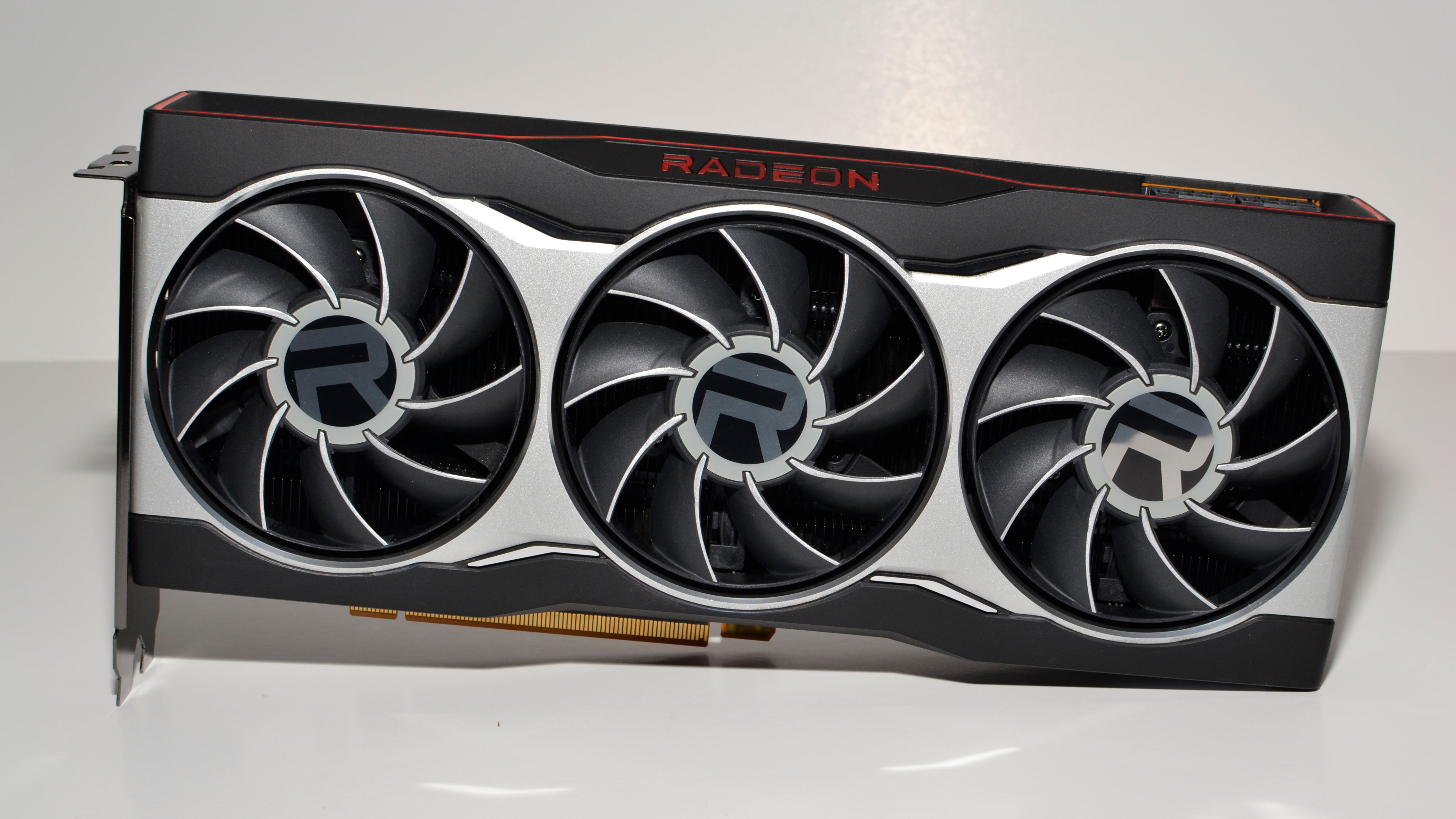
7. Radeon RX 6800
Great 1440p Graphics Card, Okay Ray Tracing
Specifications
GPU: Navi 21 XL
GPU Cores: 3840
Boost Clock: 2105 MHz
Video RAM: 16GB GDDR6 16 Gbps
TDP: 250 watts
Reasons to buy
+Excellent overall performance +Lots of VRAM and Infinity Cache +Easily beats the 3070 in non-RT
Reasons to avoid
-Good luck finding one -Middling RT performance -FSR will take a while to catch up to DLSS -Not much cheaper than 6800 XT
Take everything great about the new Navi 21 GPU that powers the 6800 XT (above), then trim it by about 10% and you get the vanilla RX 6800. You still get the full 16GB GDDR6 and 128MB Infinity Cache, but only 96 ROPs and slightly lower clock speeds. It's a reasonable compromise, but we think the 6800 XT is the better option all things considered (unless pricing eventually drops a bit more on the vanilla cards).
The RX 6800 also puts in a good showing against Nvidia's RTX 3070. In our current 9-game test suite, it's 9% faster overall. Of course it also costs 16% more, but we think having twice as much VRAM is a fair trade.
The real concerns are the same as with the 6800 XT: Ray tracing performance looks a bit weak, basically matching Nvidia's previous generation RTX 2080 Super. AMD's FSR as a DLSS alternative could help long-term, but right now it's only supported in a handful of games and can't quite match DLSS image quality. Take the RTX 3070 in DXR performance. Without DLSS, the 3070 is already 12% faster. Turn on DLSS Quality mode and the gap increases to more than 50%! Also, DLSS can be used without ray tracing, and typically looks better than temporal AA (or at least as good).
With AMD's FidelityFX Super Resolution now available, it now needs game developers to implement the feature. It's open source, plus AMD RDNA2 GPUs are in all of the next generation consoles, which means FSR will probably see plenty of uptake… eventually. For now, we'd grab a 6800 more for the rasterization prowess and not worry so much about ray tracing. Not that you can find one in stock.
Read: AMD Radeon RX 6800 review

8. GeForce RTX 3060 12GB
An Excellent Mainstream Graphics Card
Specifications
GPU: Ampere (GA106)
GPU Cores: 3840
Boost Clock: 1,777 MHz
Video RAM: 12GB GDDR6 15 Gbps
TDP: 170 watts
Reasons to buy
+Lowest cost latest gen GPU +Great overall value for 1080p/1440p +Plenty of VRAM for mainstream +Limited mining appeal
Reasons to avoid
-Sold out and overpriced -Some people want to mine -Tied with old RTX 2070 performance -12GB of limited benefit
The lowest price and performance addition to Nvidia's desktop Ampere lineup is where the cuts to processing power might have gone too far. This is the first GA106 card, with a 192-bit memory interface and 12GB VRAM (though we suspect a 6GB model will show up eventually). But with 26% fewer GPU cores compared to the 3060 Ti, and less memory bandwidth, overall performance is only on the level of the RTX 2070. So, two and a half years later, you can now match a $500 graphics card with a $330 alternative.
Or that's the theory. Unfortunately, demand has once again eclipsed supply in a big way, and we're seeing RTX 3060 12GB cards selling on eBay for over $800. That's despite the measures Nvidia took to cut Ethereum mining performance in half, which ended up being meaningless when Nvidia hacked its own drivers (on accident). Word is miners had already found other workaround, and the pricing certainly suggests that's the case.
VRAM capacity at least isn't a problem, and there are a few instances where the 3060 12GB starts to close the gap with the 3060 Ti. It never quite gets there, however, and the 3060 Ti remains the better choice if you can find one at a reasonable price.
AMD's Radeon RX 6700 XT has the same amount of VRAM, but with the large 96MB Infinity Cache it ends up performance quite a bit better — and costing quite a bit more. Maybe an RX 6700 will show up next month to provide some needed competition in the sub-$400 range, though of course those will also sell out.
If you discount ray tracing and DLSS, the RTX 3060 ends up being roughly the same performance as AMD's RX 5700 XT, 18 months later. Not exactly something to set the world on fire, but then that's typical of mainstream parts. We can only hope supply and pricing return to nominal levels sooner rather than later.
Read: Nvidia GeForce RTX 3060 12GB Review

9. Radeon RX 6600 XT
Good Mainstream Performance, Weak RT
Specifications
GPU: Navi 23
GPU Cores: 2048
Boost Clock: 2,589MHz
Video RAM: 8GB GDDR6 16 Gbps
TDP: 160 watts
Reasons to buy
+Faster than 3060 and RX 5700 XT +Power efficient design +Good 1080p performance +32MB Infinity Cache still works
Reasons to avoid
-Only 8GB VRAM on a 128-bit bus -Poor ray tracing performance -Expensive for 1080p -Still limited supply
AMD's answer to the RTX 3060 (sort of) comes via the Navi 23 architecture. Normally, we'd expect a 32 CU variant of Navi 22, dubbed the RX 6700 non-XT, but AMD trimmed CU counts, memory interface width, and Infinity Cache sizes to get a smaller and less expensive chip that still performs well. Right now, this is AMD's lowest cost current gen GPU.
Performance ends up slightly above the previous gen RX 5700 XT, which is impressive considering the memory bus has been cut in half to just 128 bits. There's a reasonable concern with the 8GB of VRAM, however, and there are certainly cases where the RTX 3060 ends up as the better choice. Still, it's surprising how much even a 32MB Infinity Cache seems to boost performance, when you look at the memory bandwidth. This is basically a chip that's smaller than Navi 10, built on the same TSMC N7 node, and it delivers 10–15% better framerates at 1080p.
There are instances where it struggles, however, ray tracing being a big one. Several games that we tested with DXR (DirectX Raytracing) support couldn't even do 20 fps at 1080p. Nvidia's RTX 3060 was about twice as fast, without using DLSS (where available). FSR doesn't really fix that, either, since it provides a similar boost in performance to both AMD and Nvidia — and even Intel — GPUs. Perhaps drivers and other tweaks will smooth out some of those idiosyncrasies, but after delivering impressive amounts of VRAM on the other Big Navi chips, the RX 6600 XT feels like a letdown.
Also, $379 as the starting point for a GPU that's ostensibly a replacement to the previous generation RX 5600 XT ($279 launch price) doesn't garner any goodwill. And while the initial launch supply at retail stores was pretty good, the RX 6600 XT is now sold out and commands prices at least 50% higher on places like eBay.
Read: AMD Radeon RX 6600 XT Review
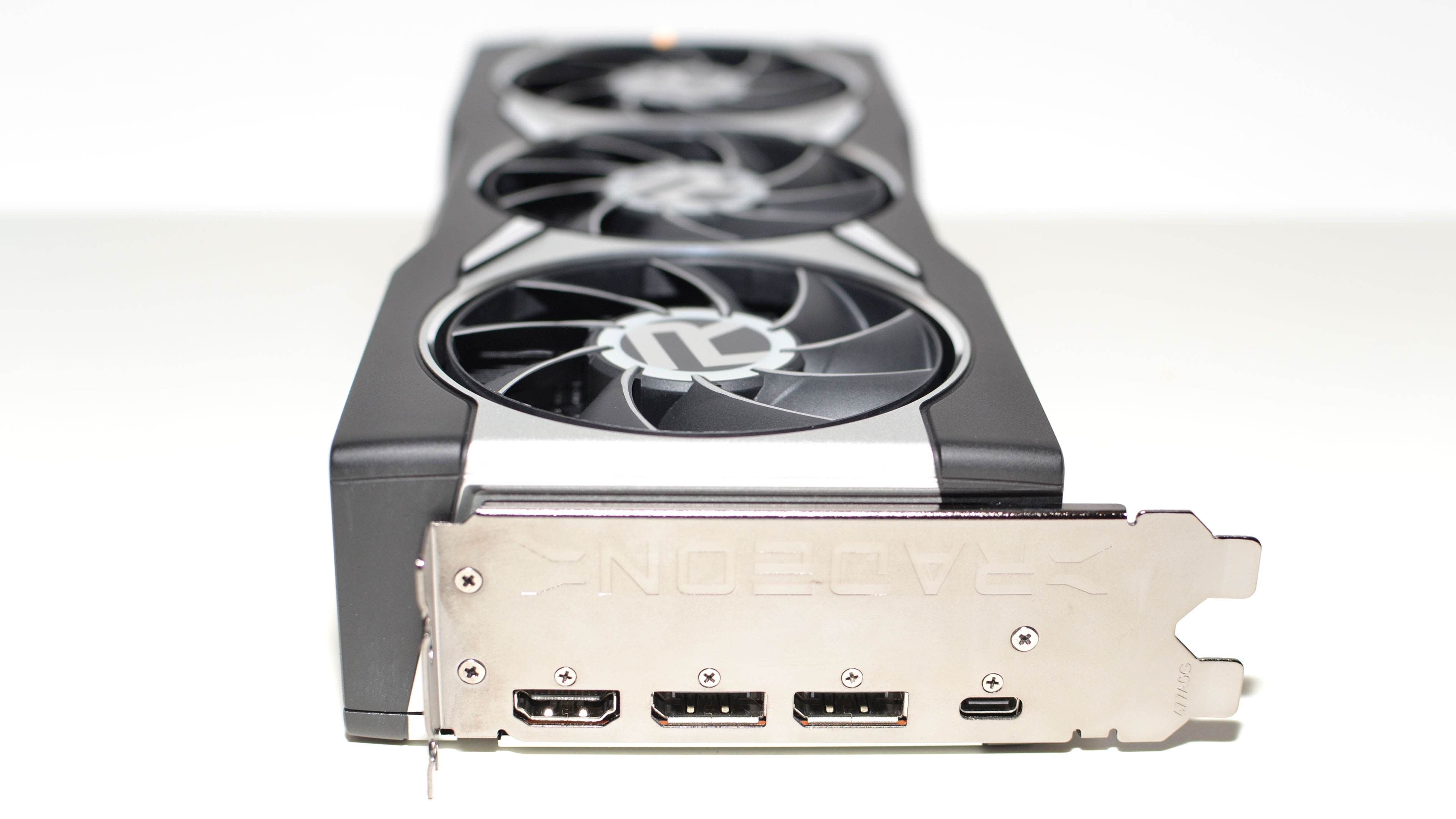
10. Radeon RX 6900 XT
AMD's Fastest GPU, Severely Expensive
Specifications
GPU: Navi 21 XTX
GPU Cores: 5120
Boost Clock: 2250 MHz
Video RAM: 16GB GDDR6 16 Gbps
TDP: 300 watts
Reasons to buy
+Excellent overall performance +Lots of VRAM and Infinity Cache +Second place in non-RT workloads +Good SPECviewperf results
Reasons to avoid
-Almost impossible to find -Not much faster than 6800 XT -Poor value overall
This is the other end of the Navi 21 spectrum. Where the 6800 cuts performance and price a bit, the RX 6900 XT boosts performance a bit and increases the (theoretical) price by over 50%. It's a big jump for small gains, and you don't even get something like more VRAM (the one saving grace of the RTX 3090). Also, good luck finding one for less than $1,500 right now.
AMD pulled out all the stops on the RX 6900 XT. It has a fully enabled Navi 21 GPU, which helps account for its scarcity. It's still a big chip as well, which means AMD is better off making more Zen 3 CPUs or console processors than trying to crank out Big Navi. Even as a mining solution, it's pretty mediocre, as the RX 6800 matches it on Ethereum hashing performance.
The same red flags are still present as well, like the mediocre ray tracing performance and lack of a direct alternative to DLSS. Basically, FSR works on everything, but DLSS only runs on Nvidia and has a three year head start on getting game developers to use it. In short, if you want the best RT experience right now, Nvidia still wins (not that you need RT to enjoy games).
Those who just want the fastest AMD GPU will still be happy with the 6900 XT. Unless by 'fastest' you're referring to mining performance, in which case the old Radeon VII still comes out over 30% faster. (Yeah, it's also selling at extreme prices these days.)
Read: AMD Radeon RX 6900 XT review

11. GTX 1660 Super
Best Mainstream Esports / 1080p High Graphics Card
Specifications
GPU: Turing (TU116)
GPU Cores: 1408
Boost Clock: 1,785 MHz
Video RAM: 6GB GDDR6 14 Gbps
TDP: 125 watts
Reasons to buy
+Available at decent prices +GDDR6 gives it a healthy performance boost over the vanilla 1660 +Turing is very power efficient, even at 12nm
Reasons to avoid
-Pricing is trending up right now -No hardware ray tracing support -Last gen tech and no DLSS
Dipping down closer to $200 (sort of), the main choice comes down to the GeForce GTX 1660 Super, the vanilla GeForce GTX 1660, or the RX 5500 XT 8GB. They're all viable candidates, but we've done the testing (see below) and the GTX 1660 Super is 15% faster than the regular 1660, and nearly 20% faster than the RX 5500 XT 8GB. Basically, we strongly encourage you to spend the extra money for the performance upgrade. Or we would, if you could find a 1660 Super for close to $230. Paying $450 for a GTX 1660 Super is not a good deal.
We've looked at the GTX 1660 vs. RX 5500 XT and declared the Nvidia card the winner, but we also think the GTX 1660 Super is better than the GTX 1660. We used to think the RTX 2060 or RX 5600 XT were even better, though increasing prices on those cards make them less attractive these days. We may see a few deals on the 5600 XT, RTX 2060, or GTX 1660 Super, though, which almost certainly isn't going to happen on the latest and greatest next-gen Ampere and RDNA2 GPUs.
Despite using TSMC 12nm FinFET, actual power use is basically identical to AMD's Navi 14 chips made using TSMC 7nm FinFET. The fact that Nvidia is faster and draws the same power while using the older manufacturing node says a lot. For $230, the GTX 1660 Super basically gets you the same level of performance as the older GTX 1070 in a more efficient design. It also comes with the enhanced Turing NVENC that makes it a great choice for streaming video.
The main drawback to the GTX 1660 Super is that we may see Ampere and Navi 2x cards push down into the $250 range the coming months. Or at least try to, depending on how the shortages continue. Either way, that's likely substantially more performance and features for the same money. GTX 1660 Super runs about as fast as a GTX 1070 while using less power, and handles 1080p quite well, but the current market conditions make buying any card questionable.
Read: Nvidia GeForce GTX 1660 Super Review
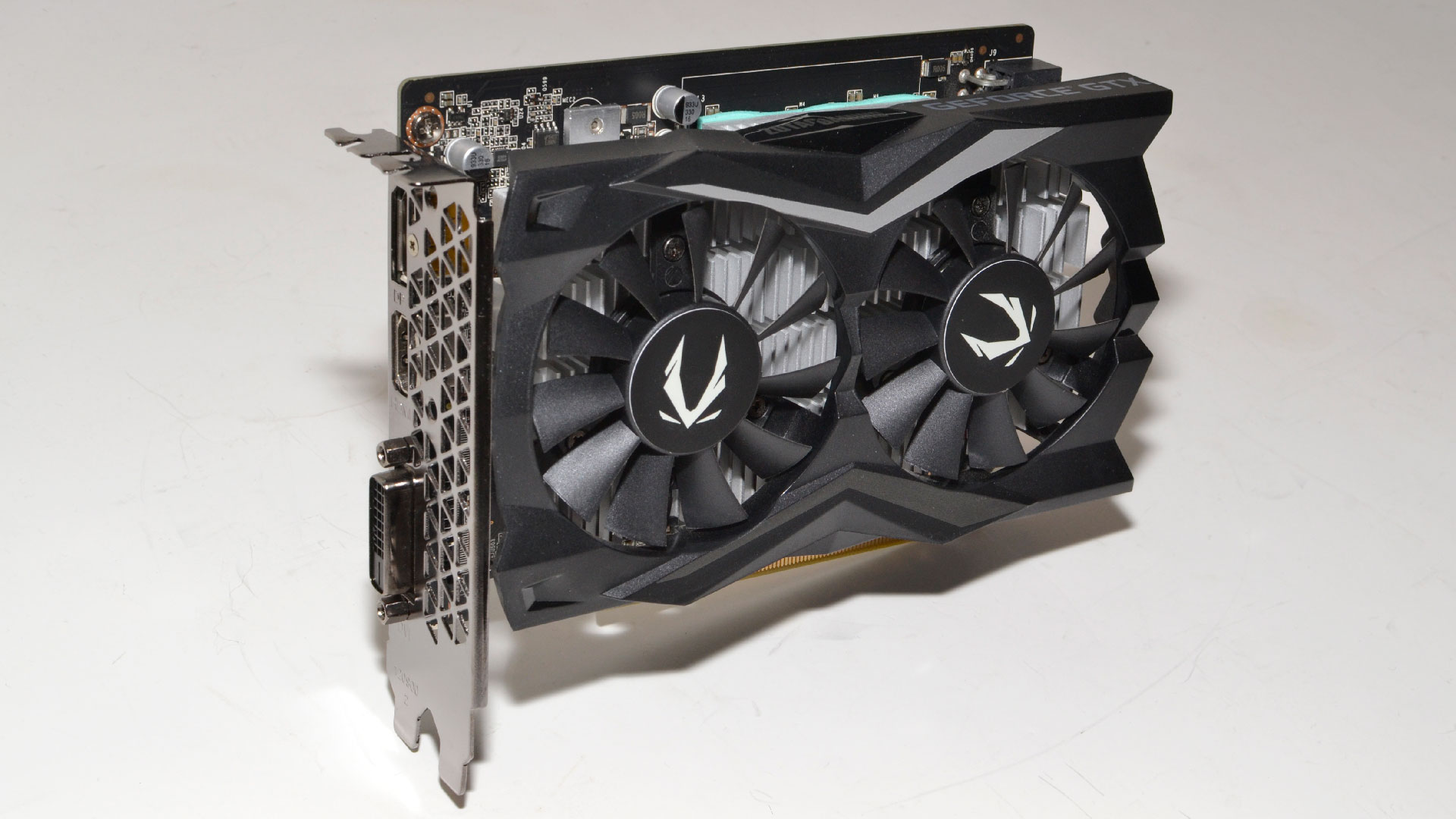
12. GTX 1650 Super
Best Budget Gaming Card That's Not Ancient Tech
Specifications
GPU: TU116
GPU Cores: 1280
Boost Clock: 1,725 MHz
Video RAM: 4GB GDDR6 12 Gbps
TDP: 100 watts
Reasons to buy
+Runs every game at decent fps +High efficiency architecture +Latest NVENC is great for video
Reasons to avoid
-4GB VRAM is limiting -Prices are inflated -Still needs a 6-pin power connector
The budget realm of GPUs often ends up going to older hardware, and now that Ampere and RDNA2 have arrived, we're one gen behind the latest and greatest. At least the GTX 1650 Super has now displaced the RX 570 4GB, which was selling for $120-$130 for what seemed like ages. The 1650 Super delivers about 30% higher performance while using substantially less power. It also costs more than the 570, or at least what the 570 used to cost — it seems supplies have finally dried up for the old AMD card. (Pour one out for Polaris.)
Unfortunately, if price is your driving concern, not even the budget GPUs are immune to the current shortages. We used to see pricing of $150-$160 for the 1650 Super, but now it's difficult to find a card for less than $300. We've also seen other GPUs (like the RX 5500 XT 8GB) shoot up in price, to the point where they start to encroach on the (also overpriced) GTX 1660 Super.
We do appreciate Nvidia including the latest NVENC hardware on the 1650 Super. That means if you want a budget streaming capable PC, this will suffice, especially for lighter fare like CSGO or LoL. It can also help with video conferencing apps, which are becoming increasingly popular in our COVID-pandemic world. Just note that unlike the previous gen GTX 1050 cards, you'll need a 6-pin power connector on the 1650 Super.
Read: Nvidia GeForce GTX 1650 Super review

13. RX 5500 XT 4GB
Best AMD 'Budget' Gaming Card
Specifications
GPU: Navi 14
GPU Cores: 1408
Boost Clock: 1,845 MHz
Video RAM: 4GB GDDR6 14 Gbps
TDP: 100 watts
Reasons to buy
+Fast enough for any current game +Efficient 7nm tech +Not as overpriced as 8GB models
Reasons to avoid
-4GB VRAM is still limiting -Prices are also inflated -Requires a 6-pin power connector
It's a bit of a wash between the GTX 1650 Super and the RX 5500 XT 4GB. They're basically equal in performance and power, and prices are just as messed up here as anywhere else. You can certainly make the argument for picking up an older used GPU like a GTX 970 for less money, but then you're getting a really old GPU and who knows what it's been put through?
The RX 5500 XT offers a decent amount of performance and can handle any game at 1080p and medium to high quality, though not necessarily at 60 fps. This really should be a $150 graphics card, so if you can find any way to hold off upgrading for the time being, we recommend waiting for prices to come back down. If you can't wait, the 5500 XT averaged nearly 90 fps in our testing at 1080p medium, giving you room to experiment if you want to improve visual fidelity.
We'll probably see RTX 3050 and RX 6500 cards at some point in the coming months, which could push down into the sub-$200 range for the latest generation hardware. Whether you'll be able to actually buy one is a different matter.
Read: AMD Radeon RX 5500 XT 4GB review
How We Test Graphics Cards
Determining pure graphics card performance is best done by eliminating all other bottlenecks — as much as possible, at least. Our current graphics card testbed consists of a Core i9-9900K CPU, MSI MEG Z390 Ace motherboard, 32GB Corsair DDR4-3600 CL16 memory, and an XPG SX8200 Pro 2TB SSD. We test across the three most common gaming resolutions, 1080p, 1440p, and 4K, at medium and ultra settings. There are technically faster CPUs now, but we've done testing and at best overall performance only improves by 1–3%, so we're sticking with the Core i9-9900K for the time being.
Where possible, we use 'reference' cards for all of these tests, like Nvidia's Founders Edition models and AMD's reference designs. Most mid-range and lower GPUs do not have reference models, however, and in some cases we only have factory overclocked cards for testing. We do our best to select cards that are close to the reference specs in such cases.
Our current test suite of games consists of nine titles. The data in the following charts is from testing conducted during the past several months. Note that Red Dead Redemption 2 does not run on all GPUs at all settings, and we have interpolated data for the overall score to keep the charts consistent. You need 6GB or more for 4K ultra, but omitting that result skews the average performance chart slightly. We interpolate, using a negative bias (meaning, slightly lower scores than we'd otherwise expect) to keep things useful.
The following charts contain the most common GPUs of the past three years. We have included everything from the RTX 3090 down to the GTX 1650, and RX 6800 down through RX 5500 XT, and nearly everything in between. We've had to cut earlier GPUs and the Titan cards from the charts to keep things manageable. (We have all the test data, though, which is how the scores and sorting are generated for the table at the top, which comes from our GPU benchmarks hierarchy). The charts are color coded with AMD in red/grey and Nvidia in blue/black to make it easier to see what's going on.
Also note that each card takes a solid day of testing, so some of the results are now outdated — meaning they were gathered on previous drivers, running previous versions of the game, possibly on an earlier version of Windows 10. We intend to do a full retest of all the current-gen and previous-gen GPUs in the near future, with a single set of drivers, after Windows 11 launches. Any anomalies in the charts should hopefully clear up then (e.g., Red Dead Redemption 2 for example has several instances where the 6800 outperformed the faster 6800 XT and even 6900 XT).
The following charts were all updated as of October 20, 2021.
1080p Medium
Image 1 of 10

Image 2 of 10

Image 3 of 10

Image 4 of 10

Image 5 of 10

Image 6 of 10

Image 7 of 10
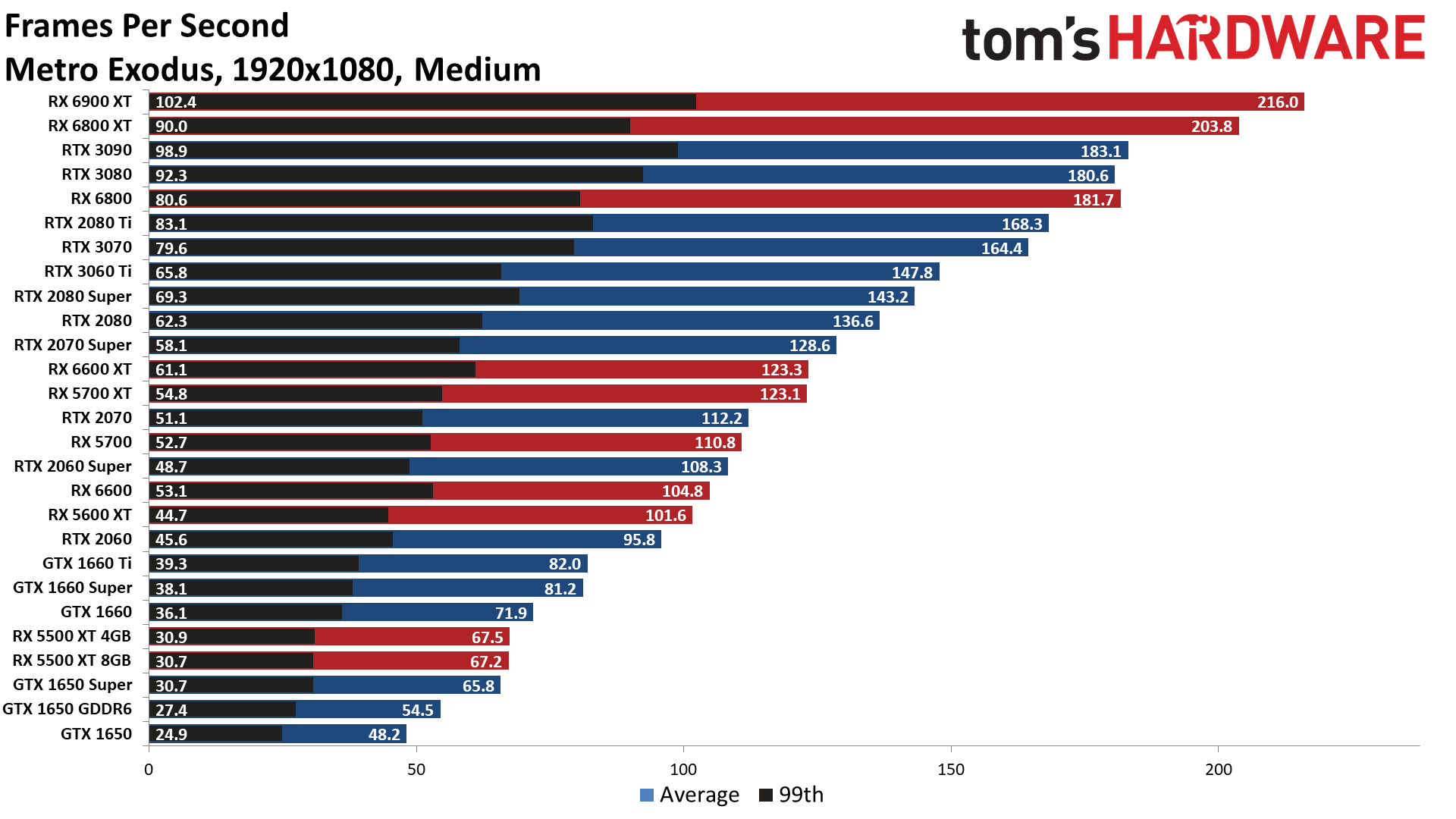
Image 8 of 10
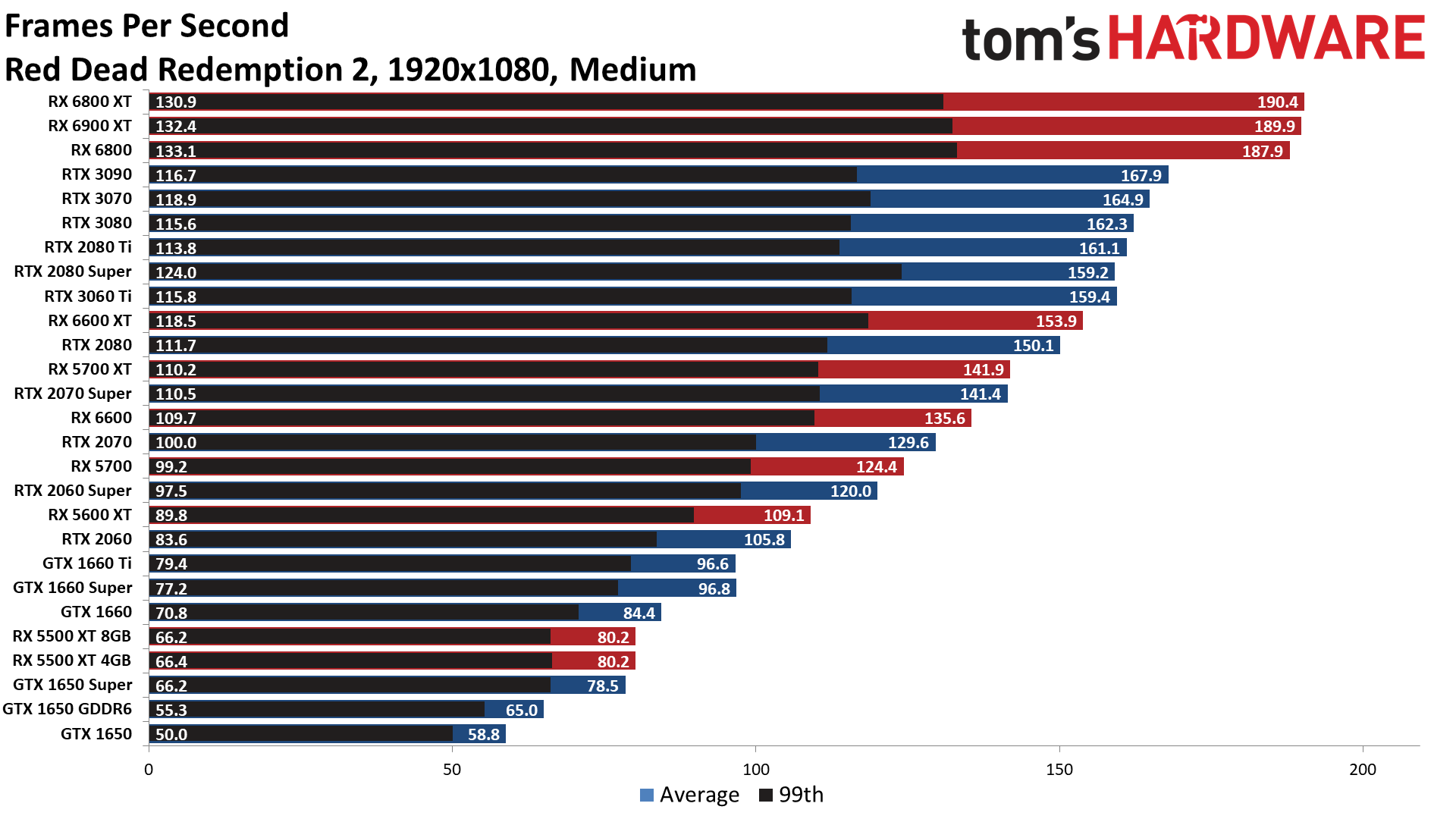
Image 9 of 10

Image 10 of 10

1080p Ultra
Image 1 of 10

Image 2 of 10

Image 3 of 10

Image 4 of 10

Image 5 of 10

Image 6 of 10

Image 7 of 10

Image 8 of 10

Image 9 of 10

Image 10 of 10
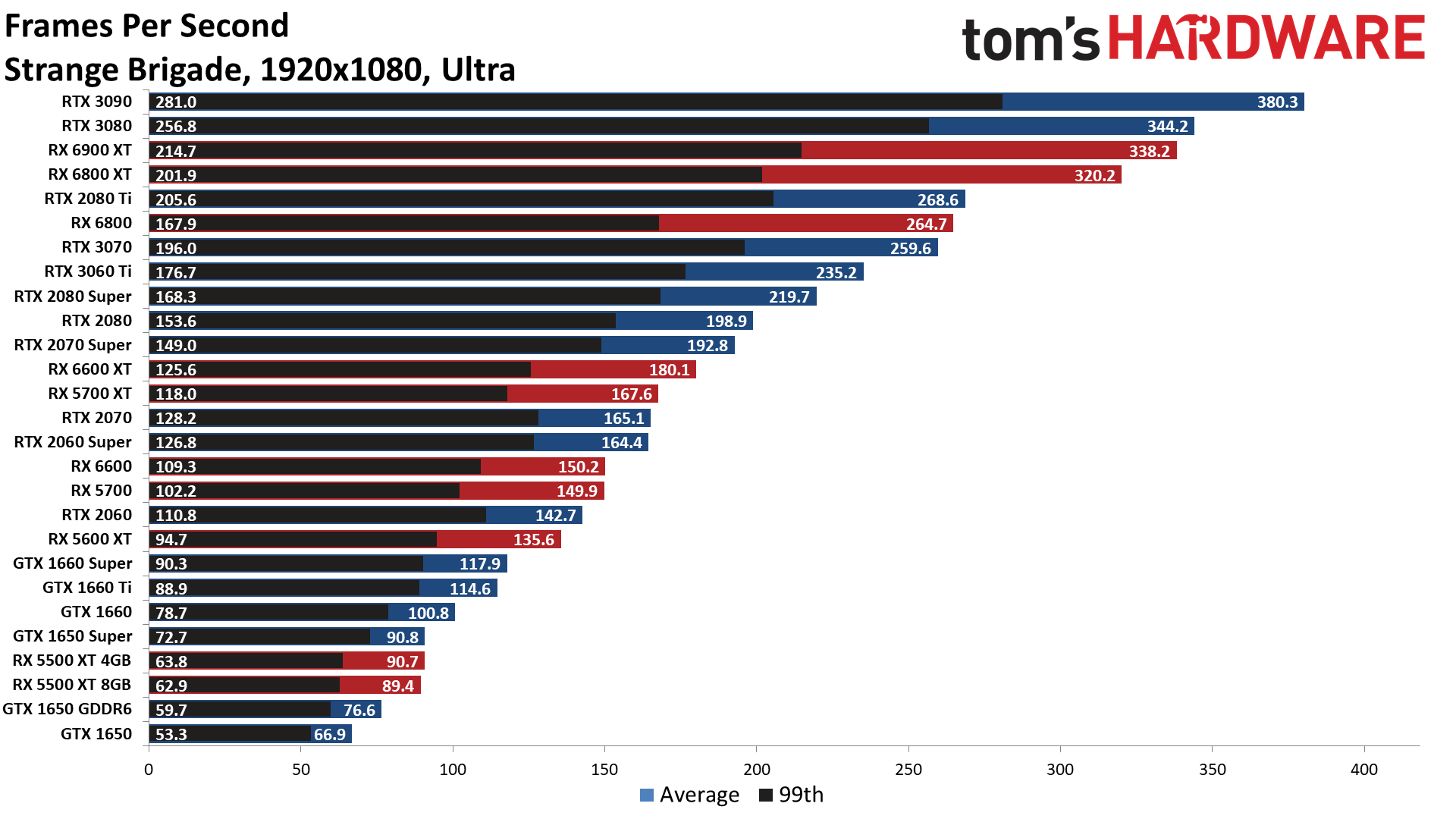
1440p Medium
Image 1 of 10

Image 2 of 10

Image 3 of 10

Image 4 of 10
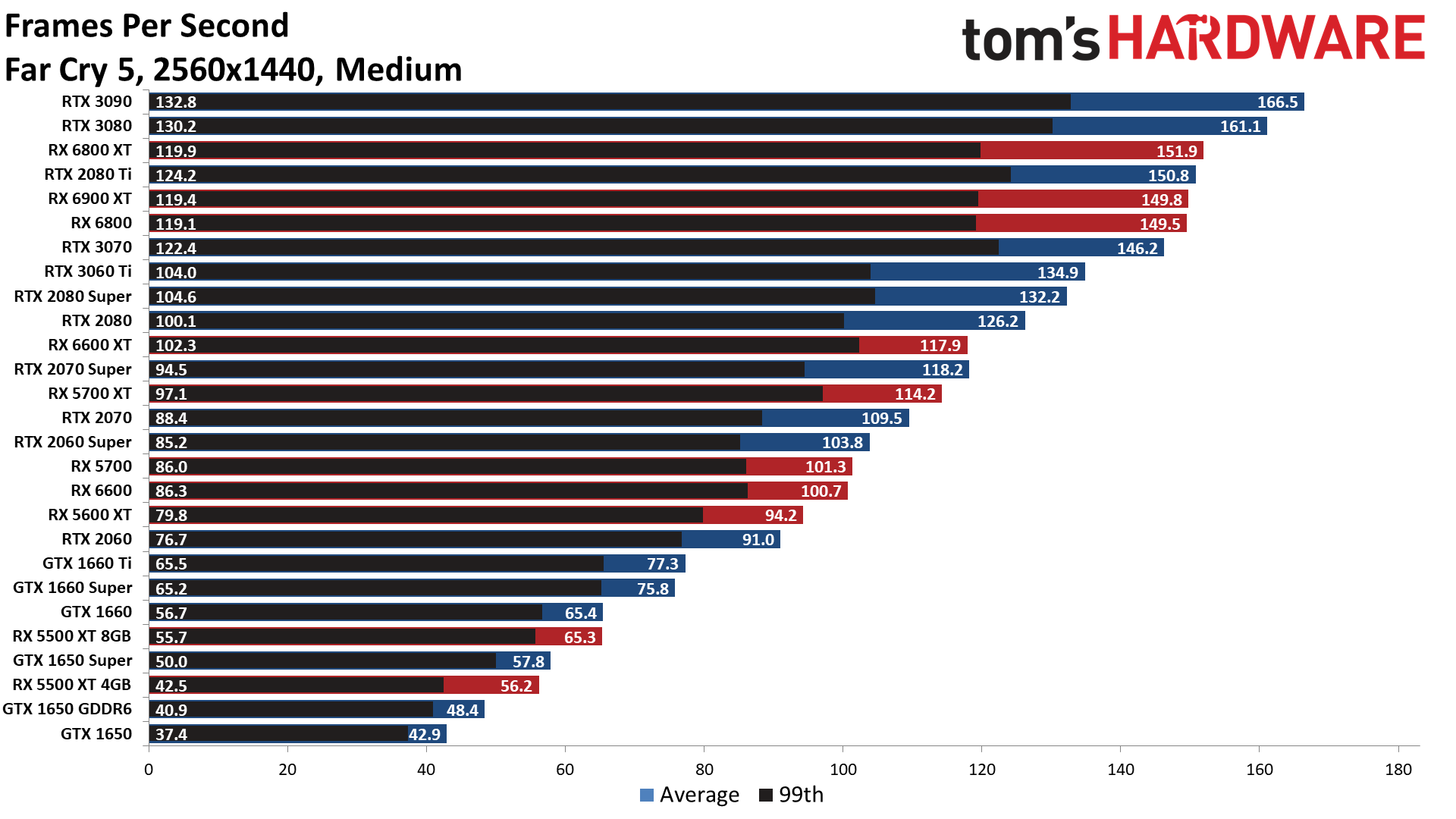
Image 5 of 10

Image 6 of 10

Image 7 of 10

Image 8 of 10

Image 9 of 10

Image 10 of 10

1440p Ultra
Image 1 of 10

Image 2 of 10

Image 3 of 10

Image 4 of 10

Image 5 of 10

Image 6 of 10

Image 7 of 10

Image 8 of 10

Image 9 of 10
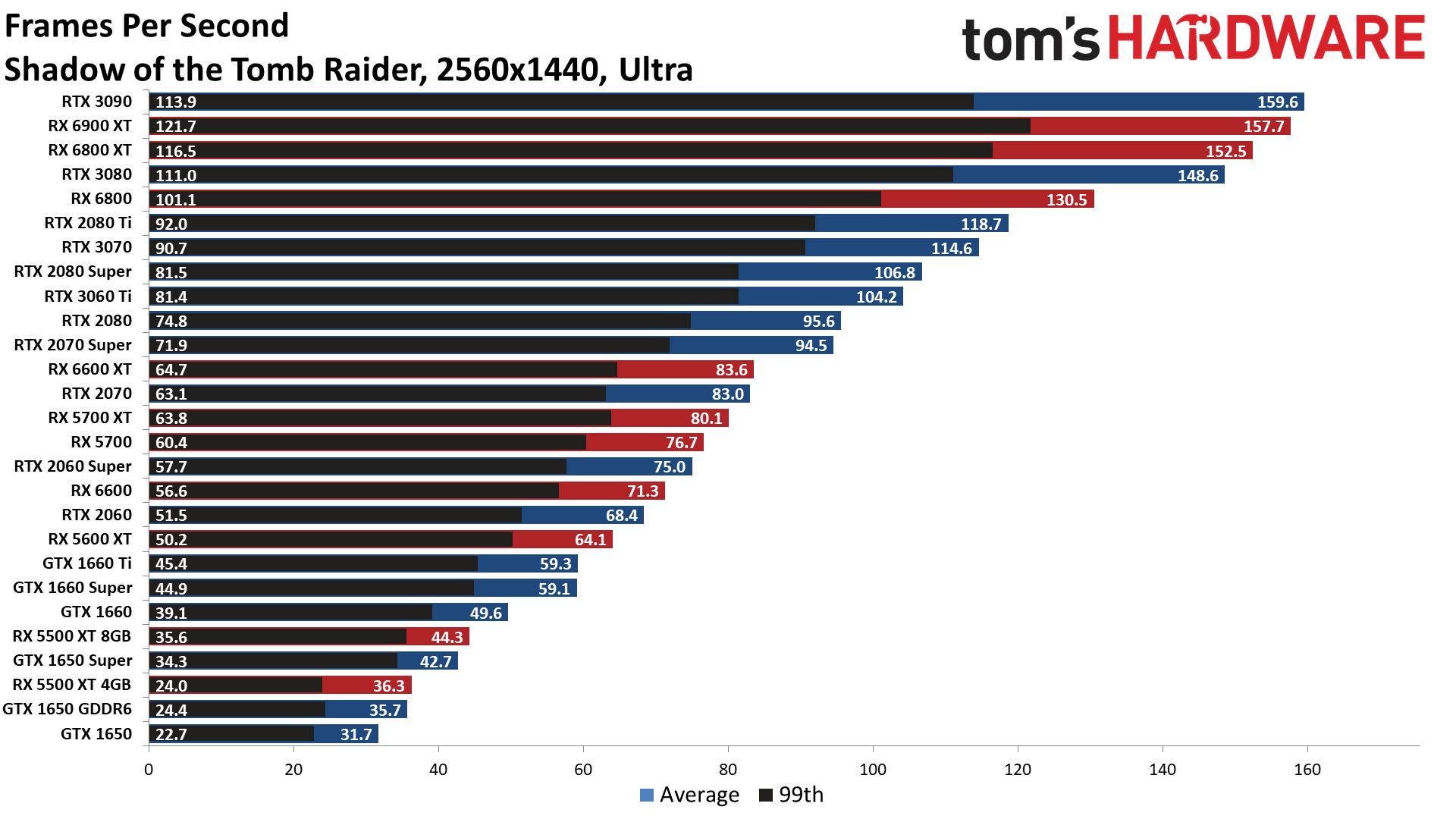
Image 10 of 10

4K Medium
Image 1 of 10

Image 2 of 10

Image 3 of 10

Image 4 of 10

Image 5 of 10

Image 6 of 10

Image 7 of 10

Image 8 of 10

Image 9 of 10

Image 10 of 10

4K Ultra
Image 1 of 10

Image 2 of 10
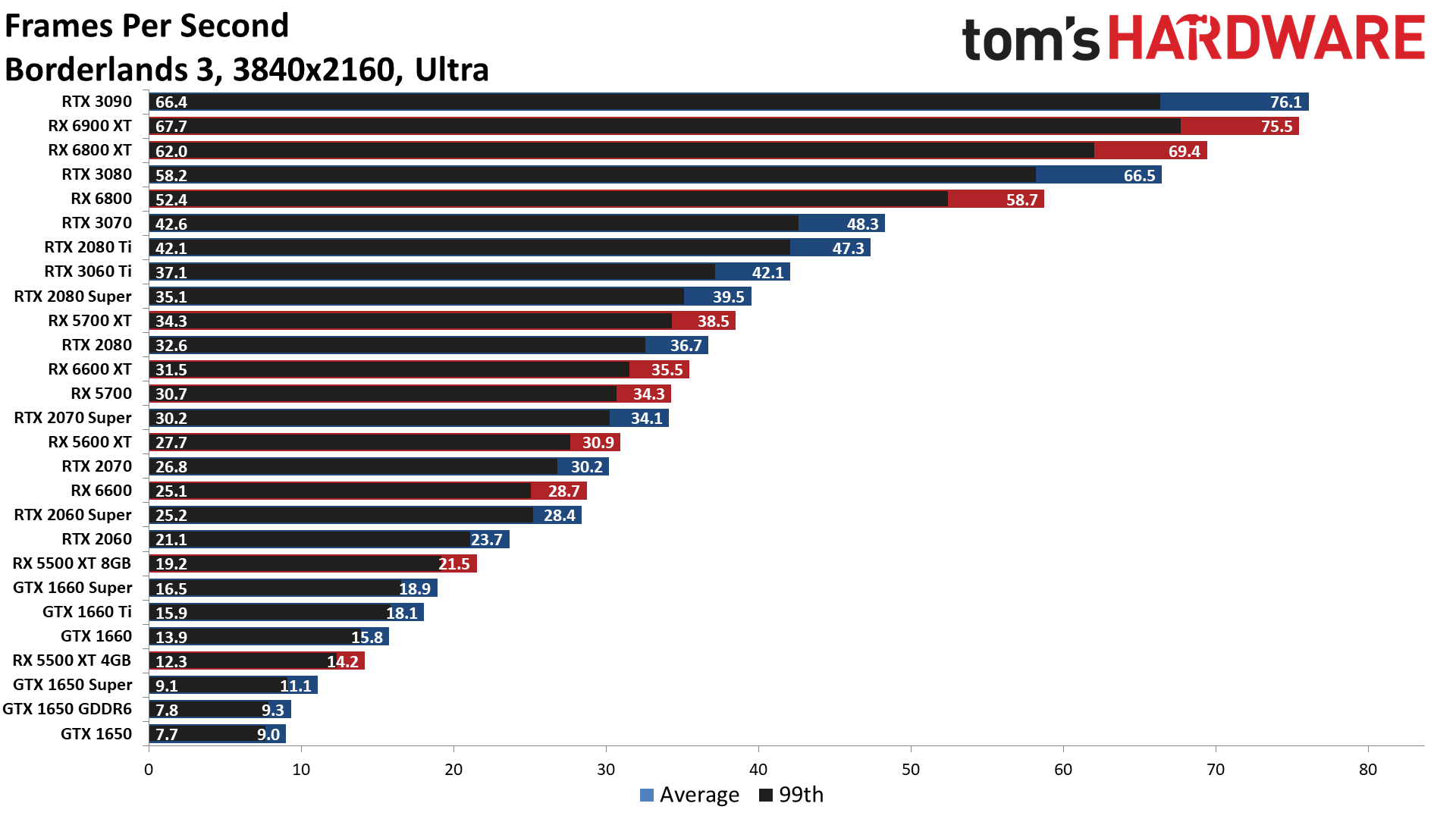
Image 3 of 10

Image 4 of 10

Image 5 of 10
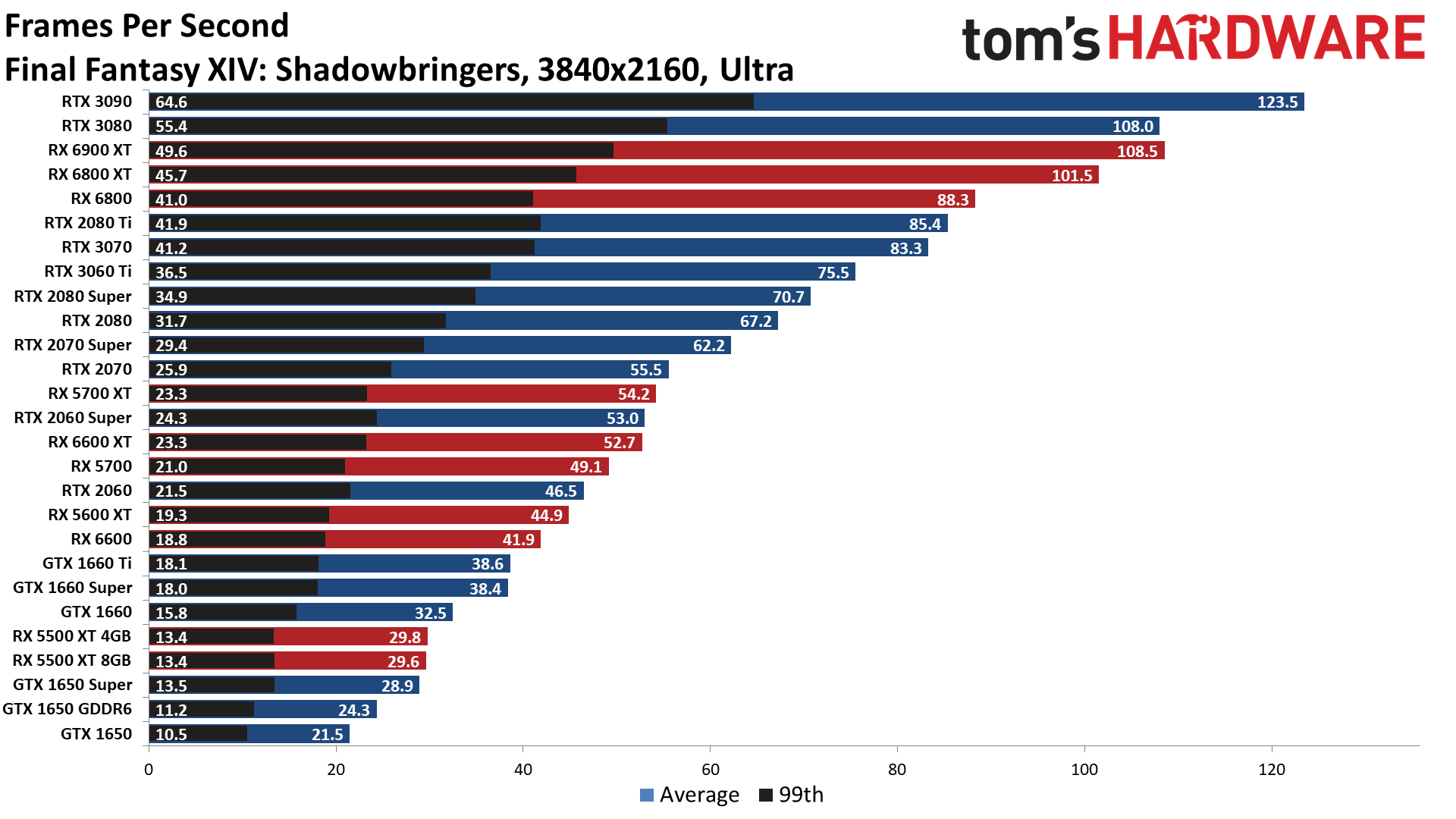
Image 6 of 10
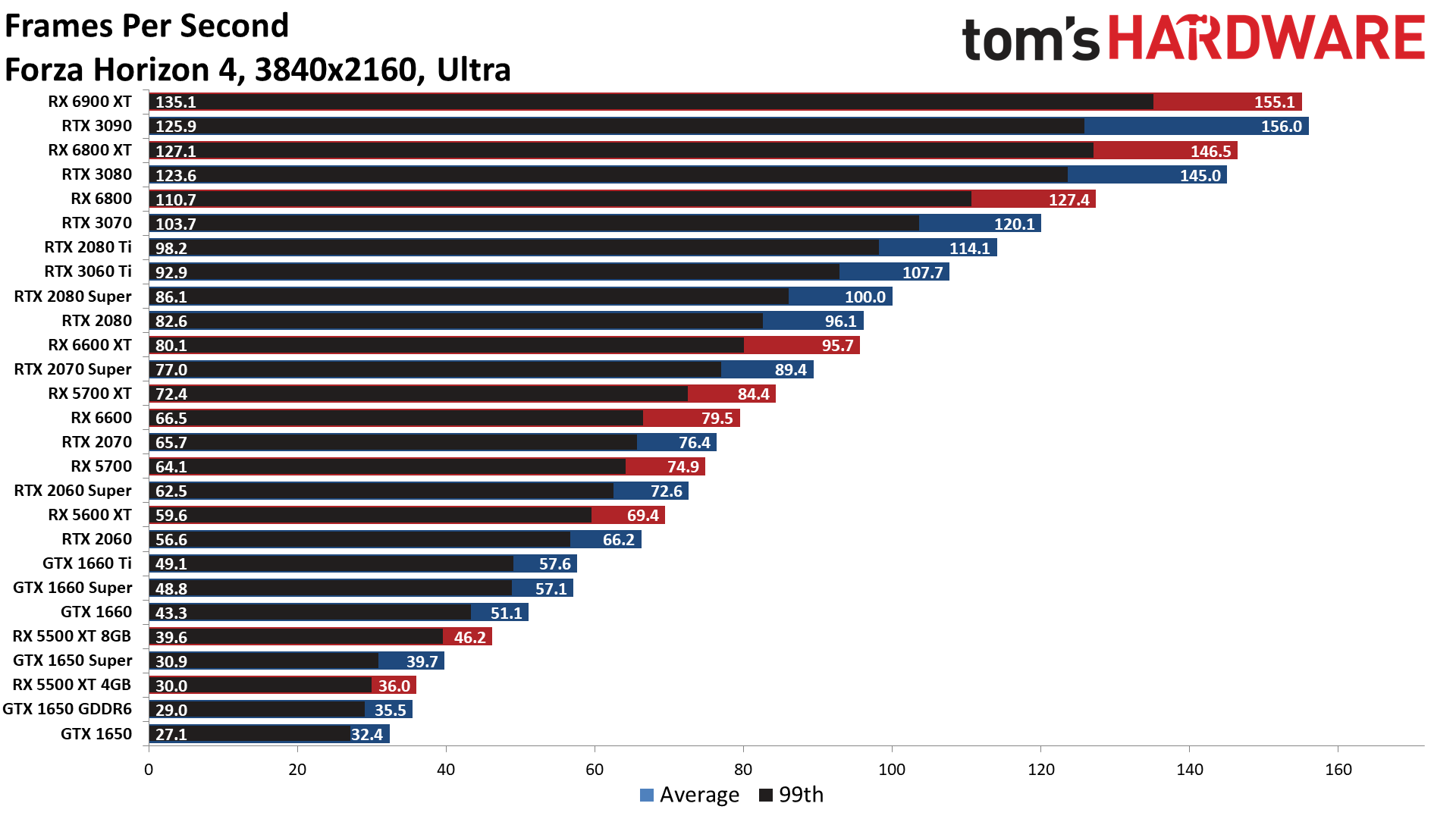
Image 7 of 10

Image 8 of 10

Image 9 of 10

Image 10 of 10

Besides performance, we also test graphics card power consumption. We tested all current GPUs using Powenetics equipment and software, and while Nvidia generally had an efficiency lead on previous generation parts, AMD's RDNA2 GPUs now rate as the most efficient options in most cases. Here are the main power charts from our testing, along with clock speeds, temperatures, and fan speeds — and we've retested the GTX 1650 Super to get correct data now.
Image 1 of 8
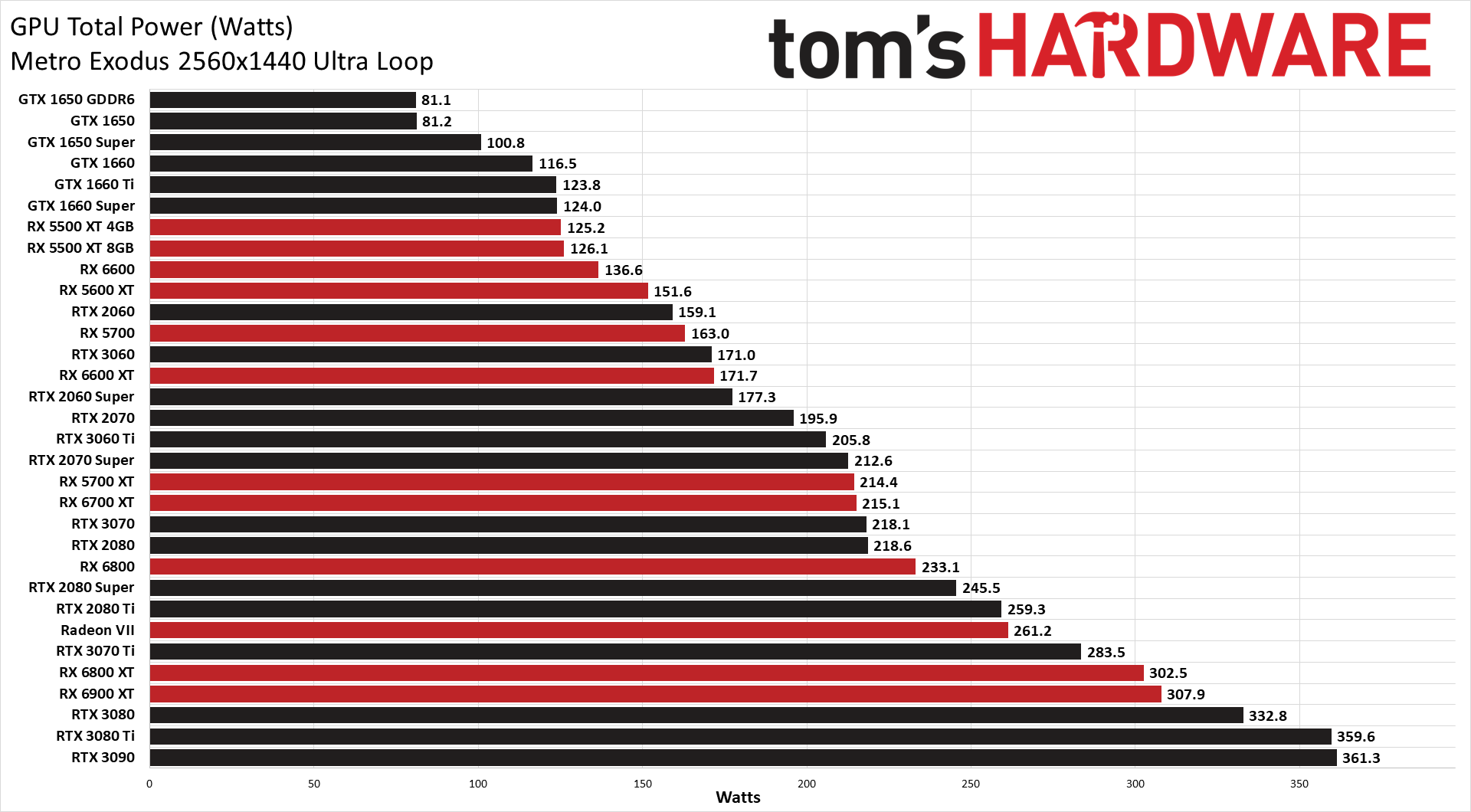
Image 2 of 8

Image 3 of 8

Image 4 of 8

Image 5 of 8

Image 6 of 8

Image 7 of 8

Image 8 of 8
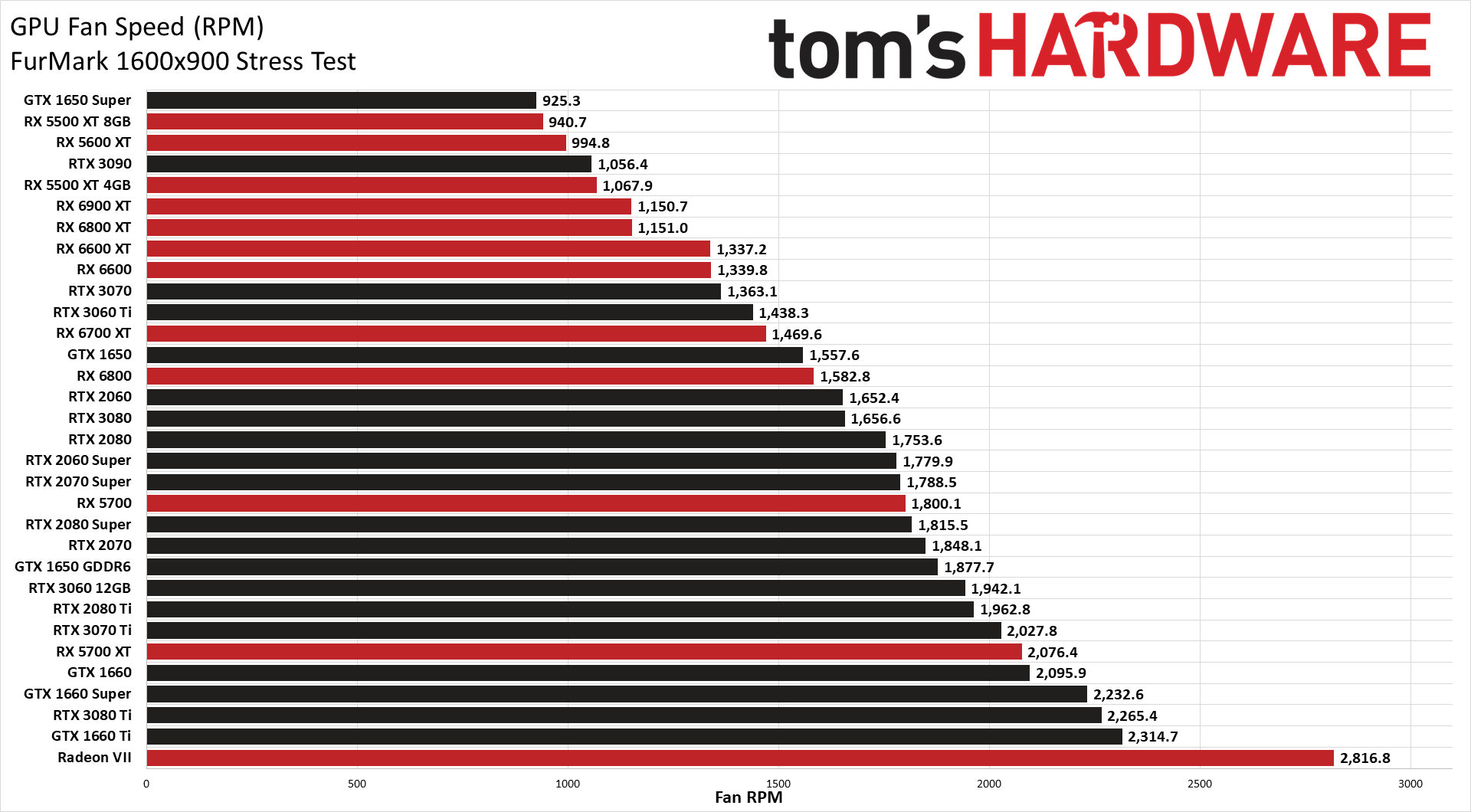
All GPUs Ranked
Our full GPU Benchmarks hierarchy ranks all current in previous generation GPUs by performance, using aggregate data from the gaming test suite. Below is the abbreviated hierarchy with all the cards you can still buy (plus a few extras) ranked in order of performance, from best to worst. The score represents aggregate performance, scaled relative to the RTX 3090.
Finding Discounts on the Best Graphics Cards
With all the GPU shortages these days, you're unlikely to see huge sales on a graphics card, but you may find some savings by checking out the latest Newegg promo codes, Best Buy promo codes and Micro Center coupon codes.
Want to comment on our best graphics picks for gaming? Let us know what you think in the Tom's Hardware Forums.
MORE: HDMI vs. DisplayPort: Which Is Better For Gaming?
MORE: Best CPUs for Gaming

Jarred Walton is a senior editor at Tom's Hardware focusing on everything GPU. He has been working as a tech journalist since 2004, writing for AnandTech, Maximum PC, and PC Gamer. From the first S3 Virge '3D decelerators' to today's GPUs, Jarred keeps up with all the latest graphics trends and is the one to ask about game performance.
best graphics design video card
Source: https://www.tomshardware.com/reviews/best-gpus,4380.html
Posted by: myersgrell1966.blogspot.com

0 Response to "best graphics design video card"
Post a Comment